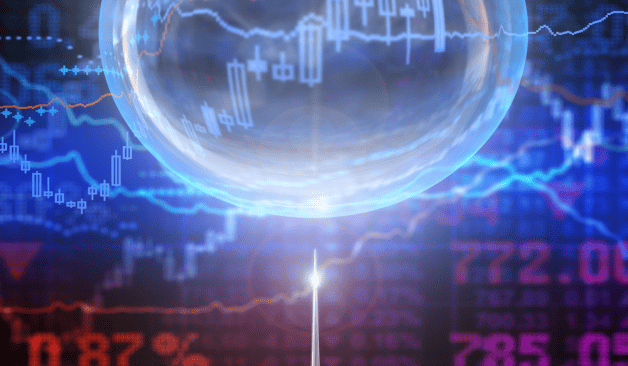
Market bubbles history and how do they work?
Did you know that the first stock market bubble was dated back in 1630 - The tulip bubble. What are market bubbles? To learn about this intriguing phenomenon, read the article till the end. Without wasting any time, let us get started.
What are economic bubbles and their types?
An economic bubble is a period of rapid price escalation for an asset or group of assets that far exceeds the asset's intrinsic value. This rapid inflation is followed by a sudden and often dramatic decrease in value, known as a bubble burst.
Let us understand the concept with an analogy.
Imagine a soap bubble. You blow air into it, and it expands quickly. The bubble keeps growing thinner and thinner, until eventually, a tiny pinprick or a change in air pressure causes it to pop.
Economic bubbles behave similarly. Asset prices inflate due to speculation and excitement, but eventually, reality sets in, and the bubble bursts, leading to a sharp decline in prices.
Below are some of the different types of economic bubbles:
- Stock market bubbles: These occur when stock prices rise to unsustainable levels, often driven by speculation and excitement about a particular industry or company.
- Housing bubbles: They occur when real estate prices rise to unsustainable levels, often fueled by easy access to credit and speculation about future price increases.
- Commodity bubbles: They occur when the prices of commodities, such as oil or gold, rise to unsustainable levels. Commodity bubbles can be caused by a variety of factors, including supply shortages, speculation, and geopolitical events.
Our focus in this article would be on the first one - stock market bubbles.
History of stock market bubbles
As mentioned at the start, the history of the stock market bubble dates back to 1630. Here are some of the events from history, which created stock market bubbles:
The Dutch Tulip Bulb Bubble: This is one of the earliest recorded economic bubbles. Tulip bulbs, especially rare varieties, became incredibly popular in the Netherlands during this time. Speculative buying drove prices up to extraordinary levels before the market crashed in 1637, leaving many investors in financial ruin.
The South Sea Bubble (1720): The South Sea Company, a British joint-stock company, was formed to trade with Spanish colonies in South America. Fueled by speculation and aggressive marketing, the company's stock price skyrocketed in 1720 before collapsing dramatically that same year. The bubble's burst had a devastating impact on the British economy.
The Wall Street Crash of 1929: The stock market in the United States boomed in the 1920s, fueled by easy credit, speculation, and a belief that stock prices would only go up. The bubble burst in October 1929, triggering a massive sell-off that led to the Great Depression, the worst economic downturn in modern history.
The Dot-com Bubble (1995-2000): Most of us know about this one, right? The rise of the internet in the 1990s led to a surge in investment in internet-based companies. Many companies had little or no profit, but their stock prices soared nonetheless. The bubble burst in 2000, leading to significant losses for investors.
Causes of market bubbles
Now that you know about the stock market bubbles, the obvious question you will have is - why do market bubbles form? To be honest, it is different to tell a reason because if you look at history, every time, there is a different reason, and the causes are complex. Easier to understand once they have burst but difficult to see as they form. However, let us look at some common factors which lead to it:
Speculation and Herd Mentality: As the stock prices begin to rise, some investors jump in not because of the asset's underlying value, but because they expect prices to keep climbing. It can create a self-fulfilling prophecy, as more and more people buy in, pushing prices even higher.
Irrational Exuberance: Sometimes, a sense of euphoria takes hold of the market, fueled by positive news stories and a belief that prices can only go up. It can lead to investors making illogical decisions based on emotions rather than a careful evaluation of the asset's value.
Lack of Regulation: A lack of regulations can create an environment where risky behavior is encouraged. It can contribute to the formation of bubbles, as investors may be less likely to be concerned about the potential for a crash.
New Technologies or Industries: The emergence of new technologies or industries can sometimes lead to bubbles, as investors get caught up in the hype and excitement surrounding the potential for future growth.
Ways to identify a stock market bubble
It is not an easy task, but doable. There are a few things you can monitor to figure out if a bubble is forming in a stock, industry, or the overall market. Here are a few things to evaluate:
- High P/E Ratios: A high P/E ratio can indicate that the stock is overvalued relative to its current profitability. However, it is essential to consider the industry average P/E ratio as well, because some sectors naturally have higher P/E ratios than others.
- Low ROE: ROE measures how effectively a company uses shareholder equity to generate profits. A low ROE suggests that the company may not be generating enough return on its investments, which could be a red flag if stock prices are rising rapidly.
- Strong momentum in the prices: Rapidly rising stock prices can be a sign of a bubble, especially, if they are not supported by strong fundamentals such as earnings growth. This momentum is often fueled by speculation and FOMO (fear of missing out).
Effect of stock market bubbles
A market bubble is not good both for investors and businesses. However, in this section, we will focus on the two major effects the stock market bubble can have on investors:
- Loss of Wealth: The most immediate and widespread effect is significant financial losses for investors who hold stocks when the bubble bursts. It can range from retirees losing their nest eggs to young investors seeing their dreams of financial security evaporate.
- Erosion of Trust: Bubbles can erode trust in the financial system, leaving investors feeling burned and hesitant to participate in the market in the future.
Before you go: How to avoid bubbles?
Avoiding bubbles completely can be tricky, but there are ways to limit your exposure. Focus on investing in companies with strong fundamentals, like healthy earnings and a track record of growth, rather than just chasing hot trends. Maintain a diversified portfolio across different asset classes to spread your risk.










